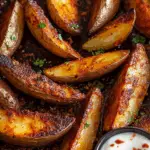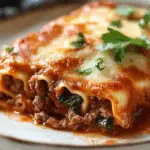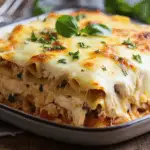These crispy Indian vegetable pakoras are a beloved snack throughout India, known for their crunchy texture and rich, spiced flavors. Made with a mix of fresh vegetables coated in a chickpea flour batter, these fritters are deep-fried to perfection, making them irresistibly crunchy on the outside while tender and flavorful inside. They pair beautifully with tangy mint chutney or sweet tamarind sauce, perfect for a cozy afternoon tea or a festive gathering.
Whether you’re new to Indian cooking or a seasoned foodie, these pakoras offer a wonderful way to enjoy vegetables with a spicy twist. They’re great for sharing at parties or just as a comforting snack on a rainy day. Plus, the recipe is easily customizable with whatever vegetables you have on hand, making it a versatile favorite in any kitchen.
Full Recipe:
-
1 cup chickpea flour (besan)
-
1/4 cup rice flour (for extra crispiness)
-
1 teaspoon cumin seeds
-
1 teaspoon coriander powder
-
1/2 teaspoon turmeric powder
-
1/2 teaspoon red chili powder (adjust to taste)
-
1/2 teaspoon garam masala
-
1 teaspoon salt (adjust to taste)
-
1/2 teaspoon baking soda
-
1 cup water (approximate, adjust to make batter)
-
1 cup thinly sliced onions
-
1 cup finely chopped potatoes
-
1/2 cup chopped spinach or kale
-
1/2 cup finely chopped cauliflower
-
1 green chili, finely chopped (optional)
-
2 tablespoons fresh coriander leaves, chopped
-
Oil, for deep frying
Directions:
-
In a large mixing bowl, combine chickpea flour, rice flour, cumin seeds, coriander powder, turmeric, red chili powder, garam masala, salt, and baking soda. Mix well.
-
Slowly add water while stirring continuously to form a thick, smooth batter. The batter should be thick enough to coat the vegetables without dripping off.
-
Add the sliced onions, chopped potatoes, spinach, cauliflower, green chili, and coriander leaves to the batter. Mix well to coat all the vegetables evenly.
-
Heat oil in a deep frying pan over medium heat. Test the oil by dropping a small amount of batter; if it bubbles and rises to the surface quickly, the oil is ready.
-
Carefully drop spoonfuls of the batter-coated vegetables into the hot oil, frying in batches. Avoid overcrowding the pan.
-
Fry the pakoras for 4-6 minutes, turning occasionally, until they are golden brown and crisp.
-
Use a slotted spoon to remove pakoras from the oil and drain on paper towels.
-
Serve hot with mint chutney or tamarind sauce.
Prep Time: 15 minutes | Cooking Time: 20 minutes | Total Time: 35 minutes
Kcal: Approx. 180 kcal per serving | Servings: 4 servings
Introduction to Indian Vegetable Pakoras
Indian vegetable pakoras are one of the most iconic and beloved snacks in Indian cuisine. Known for their irresistible crunch and complex layers of spice, pakoras are essentially vegetable fritters made from fresh vegetables dipped in a seasoned chickpea flour batter and deep-fried until golden. They are enjoyed throughout India and have also gained global popularity, thanks to their bold flavors and versatility. The word “pakora” itself comes from the Hindi language and generally refers to any vegetable or meat coated in batter and fried until crisp.
These fritters are often enjoyed as an appetizer, snack, or tea-time treat and can be found at street stalls, restaurants, and family kitchens alike. The combination of textures — crispy exterior and tender, flavorful interior — along with the aromatic spices, make pakoras an ultimate comfort food, especially when served hot with tangy chutneys or sauces.
Cultural Significance and Occasions
Pakoras hold a special place in Indian culture and cuisine. They are a staple during monsoon seasons, as many Indians love to enjoy pakoras with a steaming cup of chai (tea) while watching the rain. The crispy, warm fritters are the perfect companion to the cool, wet weather and offer both comfort and warmth.
Pakoras are also widely enjoyed during festive occasions and celebrations such as Diwali, Holi, and family gatherings. Their simplicity and deliciousness make them an easy crowd-pleaser, and they can be quickly prepared in large batches, making them ideal for parties or large family meals.
Vegetables and Variations
One of the great strengths of pakoras is their versatility. While the basic recipe involves a mix of vegetables coated in chickpea flour batter, you can customize the choice of vegetables according to your preference and availability. Common vegetables used include onions, potatoes, cauliflower, spinach, and sometimes green chili for a spicy kick. Other options can include carrots, zucchini, eggplant, or even paneer (Indian cottage cheese) for variation.
This adaptability means pakoras can be vegan or vegetarian-friendly, gluten-free (thanks to chickpea flour), and cater to many dietary needs. The batter can also be adjusted with additional spices or herbs to create unique regional variations or personal twists on the classic recipe.
The Role of Chickpea Flour
Chickpea flour, also known as besan, is a key ingredient in pakoras and contributes much more than just holding the vegetables together. This flour is made from ground chickpeas and is naturally gluten-free, high in protein, and packed with nutrients. It gives pakoras their signature nutty flavor and crispy texture after frying.
The flour also absorbs the spices well, creating a batter that is aromatic and flavorful. Often, a small amount of rice flour or semolina is added to the batter to enhance crispiness further. The chickpea flour batter’s ability to cling to vegetables and create a crunchy shell during frying is essential for the perfect pakora.
Spices and Flavor Profile
Pakoras are known for their bold spice profile, which is a harmonious blend of aromatic and warming spices. Common spices include cumin seeds, coriander powder, turmeric, red chili powder, and garam masala. Each spice adds its unique note — cumin adds earthiness, turmeric contributes vibrant color and warmth, red chili powder brings heat, and garam masala adds depth with a blend of spices like cinnamon, cloves, and cardamom.
The spices are balanced carefully to create a flavorful but not overpowering snack. The addition of fresh ingredients such as chopped green chilies and coriander leaves further elevates the taste and freshness of the pakoras.
Cooking Techniques and Tips
The process of making pakoras may seem simple, but achieving the perfect balance of texture and flavor requires attention to detail. The batter should be thick enough to coat the vegetables evenly without dripping off, which helps create a crisp crust during frying.
Deep-frying at the right temperature is critical — too hot, and the pakoras will brown on the outside but remain uncooked inside; too cool, and they will absorb excess oil, becoming greasy rather than crispy. Maintaining medium heat and frying in small batches ensures even cooking and the best texture.
Using fresh oil and draining the fried pakoras on paper towels helps reduce excess oiliness, keeping them light and crunchy. Pakoras are best served immediately while still hot and crispy, as they tend to lose their crunch as they cool.
Serving Suggestions and Pairings
Pakoras are traditionally served hot and accompanied by chutneys or dipping sauces that provide a contrast to the crunchy, spiced fritters. Mint chutney, made with fresh mint, coriander, green chilies, and lemon juice, offers a refreshing and slightly tangy complement. Tamarind chutney adds a sweet and sour note that balances the heat and spices perfectly.
Besides chutneys, pakoras can also be served alongside yogurt-based dips or sprinkled with chaat masala (a tangy Indian spice blend) to enhance the flavor further. They make a perfect snack for afternoon tea or a starter for a larger Indian meal.
Health Considerations
While pakoras are deep-fried and therefore indulgent, they can still be enjoyed as part of a balanced diet when eaten in moderation. Using fresh vegetables increases the nutritional content, providing fiber, vitamins, and minerals. The chickpea flour adds protein and is naturally gluten-free, making pakoras accessible to many dietary needs.
For a healthier version, pakoras can be shallow fried or baked, though the texture will differ slightly from the traditional deep-fried version. Additionally, choosing a healthier oil with a high smoke point, such as sunflower or canola oil, can help make the snack slightly lighter.
Global Popularity and Fusion Ideas
Pakoras have transcended Indian cuisine and become popular worldwide, especially in countries with large South Asian communities. You’ll find pakora-inspired snacks in fusion cuisines, including pakora tacos, pakora wraps, or even pakora sandwiches, where the crispy fritters add texture and flavor to a variety of dishes.
Their versatility makes pakoras an excellent base for culinary creativity, allowing cooks to experiment with new ingredients and serve them in innovative ways while keeping the core spirit of this delicious snack intact.
Conclusion
Indian vegetable pakoras are much more than just fried snacks; they represent a rich cultural heritage and the love of bold, spiced flavors. Their crispy texture, aromatic spices, and the comforting warmth they provide make them a favorite for many, whether during monsoon season, festive occasions, or everyday snacking.
The beauty of pakoras lies in their simplicity and adaptability. You can use almost any vegetable, customize the spice levels, and tailor the recipe to suit your dietary preferences. Serving them hot with a variety of chutneys makes pakoras a delightfully flavorful treat that brings people together and offers a taste of authentic Indian street food.
Whether you are a seasoned cook or new to Indian cuisine, making pakoras at home is a rewarding experience that fills your kitchen with enticing aromas and results in a satisfying snack loved by all ages. Next time you crave something crunchy and flavorful, try making these golden, spiced vegetable fritters — a timeless recipe that never fails to impress.






